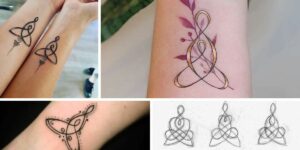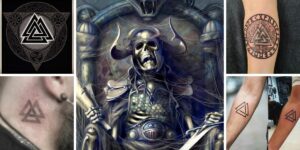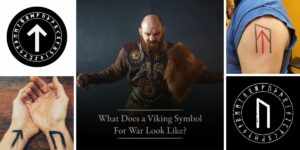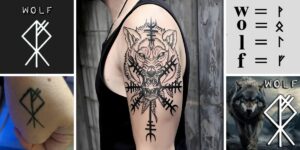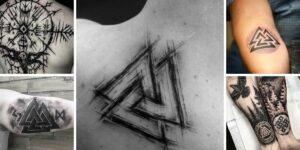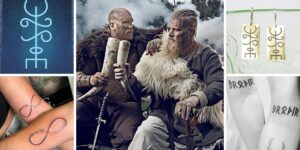Viking symbols hold a profound place in Norse mythology, encapsulating beliefs about life, death, and the cosmos. Among these, Viking symbols for death stand out for their intricate designs and spiritual significance, reflecting the Norse view of mortality as a passage to another realm. Symbols like the Valknut, runes, and imagery tied to deities such as Hel, the Norse goddess of death, reveal how Vikings honoured the fallen and navigated the mysteries of the afterlife. The fascination with these symbols, including the Norse death symbol and Viking rune of death, persists in modern culture, inspiring everything from tattoos to jewellery. This article delves into the meanings behind these powerful emblems, exploring their historical roots and cultural resonance, offering a glimpse into the Viking worldview.
The Valknut: The Most Famous Viking Symbol for Death
The Valknut is arguably the most iconic Nordic symbol for death, deeply tied to Odin, the Allfather in Norse mythology. Comprising three interlocking triangles, the Valknut is often interpreted as a representation of the cycle of life, death, and rebirth, or the transition to the afterlife. Its name, derived from Old Norse words valr (slain warriors) and knut (knot), underscores its association with fallen warriors chosen by Odin for Valhalla.
Archaeological findings, such as those on runestones and Viking ship burials, often feature the Valknut alongside scenes of sacrifice or battle, reinforcing its link to death and divine selection. As a Viking death symbol, it embodies the bravery of warriors and their journey to the afterlife. The Valknut’s enigmatic design continues to captivate, appearing in modern art and tattoos as a timeless Norse symbol of death, reflecting its enduring spiritual power.
Sources: Valhalla Vikings, Viking Style.
Hel, the Norse Goddess of Death, and Her Symbols
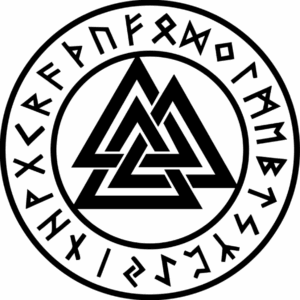
In Norse mythology, Hel is the enigmatic goddess who presides over the underworld, also named Hel, where souls not destined for Valhalla reside. As the daughter of Loki, Hel is depicted as a half-living, half-dead figure, embodying the duality of existence. Hel Norse goddess symbols often include dark serpents, skulls, or imagery of decay, reflecting her dominion over the dead. These symbols evoke the inevitability of death and the solemnity of the afterlife in Viking beliefs.
Unlike the glorious ascent to Valhalla, Hel’s realm was a colder, quieter place for those who died of natural causes or old age. Her symbols, though less prominent in Viking art, were significant in funerary rituals, representing acceptance of mortality. The Norse death symbol tied to Hel underscores the balance between honouring the dead and embracing the natural cycle, making her imagery a vital part of Viking spiritual tradition.
Nordic Runes for Life and Death
Runes, the ancient alphabetic symbols of the Norse, were more than a writing system—they carried magical and spiritual weight. Among the Viking Nordic runes for death, two stand out: Eihwaz and Hagalaz. The Eihwaz rune, associated with the yew tree, symbolises death, endurance, and transformation due to the tree’s toxic yet resilient nature. It was often used in rituals to honour the deceased or protect against spiritual harm.
Hagalaz, linked to hail, represents destruction and renewal, embodying the Norse symbol for life and death. Its chaotic energy signifies the inevitability of change, including mortality. These runes were carved into stones or weapons, believed to guide souls or ward off malevolent forces. The Viking rune of death, whether Eihwaz or Hagalaz, was integral to Viking rituals, reflecting their reverence for the cyclical nature of existence and the mysteries beyond.
Other Viking Symbols Connected to Death
Beyond the Valknut and runes, other Viking symbols are tied to death, each with unique significance. The Ouroboros, a serpent eating its own tail, is a potent Nordic symbol of death and rebirth, symbolising the eternal cycle of life. Found in Viking art, it reflects the belief that death is not an end but a transformation. Similarly, Gungnir, Odin’s mythical spear, is sometimes associated with death due to its role in battle and sacrifice, marking the warrior’s path to the afterlife.
These lesser-known symbols, while not as prominent as the Valknut, enrich the tapestry of Norse death symbols. They appear in carvings and sagas, often alongside motifs of ravens or wolves, animals sacred to Odin. As Norse symbols of death, they highlight the Vikings’ complex understanding of mortality, blending reverence, fear, and acceptance into their cultural narrative.
Viking symbols for death, from the enigmatic Valknut to the evocative runes like Eihwaz and Hagalaz, offer a window into the Norse perspective on mortality and the afterlife. These symbols, including the Norse death symbol and Viking rune of death, are not mere relics but vibrant emblems that continue to resonate in modern culture, from tattoos to literature. They reflect a worldview that embraced death as a natural part of existence, guided by deities like Hel and Odin. By exploring these Viking death symbols, we connect with a rich heritage grounded in courage, spirituality, and respect for the unknown. Dive deeper into Norse mythology to uncover more about these timeless icons and their enduring legacy.
DOWNLOAD Viking Symbols for Death – Valknut [FULL HD] [2K]
Nordic Symbol for Mother and Son: A Deep Dive into Meaning
Table of ContentsThe Valknut: The Most Famous Viking Symbol for DeathHel, the Norse Goddess of
1 Comment
Jun
Norse Symbols for Death: Exploring Viking Runes, Deities, and Iconic Imagery
Table of ContentsThe Valknut: The Most Famous Viking Symbol for DeathHel, the Norse Goddess of
Jul
Nordic Rune for War: Powerful Viking Symbols of Strength and Victory
Table of ContentsThe Valknut: The Most Famous Viking Symbol for DeathHel, the Norse Goddess of
Jul
Nordic Rune for Wolf: Symbols, Meanings & Viking Connections
Table of ContentsThe Valknut: The Most Famous Viking Symbol for DeathHel, the Norse Goddess of
Jul
Viking Symbols for Death: Exploring Norse Mythology’s Darkest Icons
Table of ContentsThe Valknut: The Most Famous Viking Symbol for DeathHel, the Norse Goddess of
Jun
Nordic Rune for Friendship: Meaning, Symbols, and Viking Tattoo Ideas
Table of ContentsThe Valknut: The Most Famous Viking Symbol for DeathHel, the Norse Goddess of
Jul


